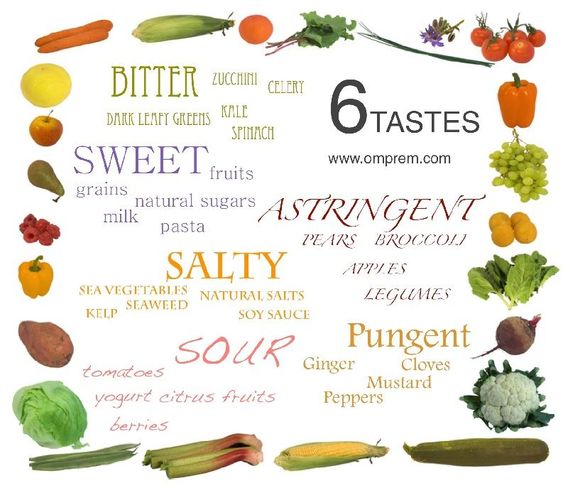From ancient times to today, six tastes of Ayurveda have remained relevant to our lives as a source of healing. Continue reading to learn the power of cooking with the six tastes.
Ayurveda is a 5,000-year-old system of healthcare that remains as relevant today as it was then—perhaps even more so if you consider the sorry state of nutrition in America today.
The basic principle of the six tastes is simple: include a balance of sweet, sour, salty, bitter, pungent, and astringent in your meal, and you are practically guaranteed to experience satisfaction from your meal. You will also be going a long way toward ensuring your health.
I say this from personal experience. I have practiced Ayurvedic cooking with the six tastes for over 25 years and experienced profound inner joy and satisfaction from my food as a result.
You, too, can experience this, by learning to incorporate the six tastes in your meals. Below are the exact seven steps I used to master the cooking with the six tastes.
1. Plan Your Meal
In practice, this means thinking about including some of each flavor—sweet, sour, salty, bitter, pungent, and astringent—in your meal.
Start with your main ingredient. Are you cooking squash and grains? Well, that is very sweet. What will you add to balance the sweetness with other tastes? Please view this chart from my blog, Buttered Veg.
2. Source Quality Ingredients
Next, source quality ingredients and prepare them with a calm mind according to your plan.
For Ayurvedic cooking, always consider first what is in season, and what is available locally. Eating seasonally optimizes the potential for balance and flavor creation.
Balance comes from eating what nature provides, and flavors are always optimal when produce is fresh.
3. Cook Mindfully
When you cook, stay attentive to the amount of heat you are using, and the timing of adding the ingredients.
Give your food the time it needs at each stage of the cooking process to fully transform your raw ingredients into a harmonious meal.
Do not be in a rush while cooking. The key to experiencing cooking as a joyful meditation is giving yourself liberal time to cook.
If you are starving, consider eating a snack so that you are not anxious to finish. Fruit is a great pre-dinner snack because it is best to eat fruit on an empty stomach, and it takes about half an hour to digest.
Another good option is to make an herbal tea and enjoy it while cooking.
4. Present Your Food Attractively
Once the food is ready, serve it attractively on a plate or in a bowl. Visual appeal makes a difference in how the mind receives the food.
5. Analyze the Results
When you sit down to eat, mindfully taste your food. Ask yourself, “how does it taste?” Analyze whether any of the flavors are missing.
You’ll know if something is missing because your food will taste “meh,” otherwise known as lacking in interest or unimpressive.
Another common issue is that your food will have too much of one or two tastes. It could be too salty, too sweet, too sour, or too oily. These are the most common problems in food today. Another common problem is the missing bitter flavor.
Contrary to how most people feel about avoiding bitter at all costs, this taste is essential. You don’t need much, but it is necessary to complete the harmony that is becoming your meal. Bitter taste comes from lettuces, kale, turmeric, cumin, and lime.
6. Add-In the Missing Ingredient(s)
Once you understand what is missing, go back to the kitchen and grab a bit of “this or that.”
For example
- A squeeze of fresh lemon to balance the salt;
- A pinch of salt to balance the sweet;
- A sweet relish or more food that isn’t sour to balance the sour;
- Something dry and crunchy, such as pita chips or flatbread, to balance the bitter, or too much oil.
- Some fresh turmeric root, or a bit of fresh arugula, to add bitter.
7. Enjoy The Experience of Blissful Food
You’ve added the extra item to your meal … and voila! You discover a transformation has taken place!
Suddenly your food sings with flavor. One could even say it tastes blissful.
Your food can be this good! It really isn’t hard to achieve once you understand it and practice a bit.

Andrea Hayley-Sankaran is the founder of Good Gut Ayurveda, a certified Ayurvedic Digestive Health Coach, and creator of Happy Eater, a 6-week program that helps purpose-driven entrepreneurs and professionals take control of their health, and unlock their energy, freedom, and FLOW.
Andrea is a vegetarian chef of 25 years who’s known as the “joyful chef” because of her infectious love for cooking. Students rave about their cooking class experiences as they experience her signature mindful approach to cooking and eating. They especially appreciate learning how to cook vegetarian food that tastes so amazing they don’t miss the meat.
Through her programs, coaching, writing, and speaking, Andrea empowers her community to find balance and attain health and healing through individualized diet and lifestyle habits informed by the ancient wisdom of Ayurveda.

